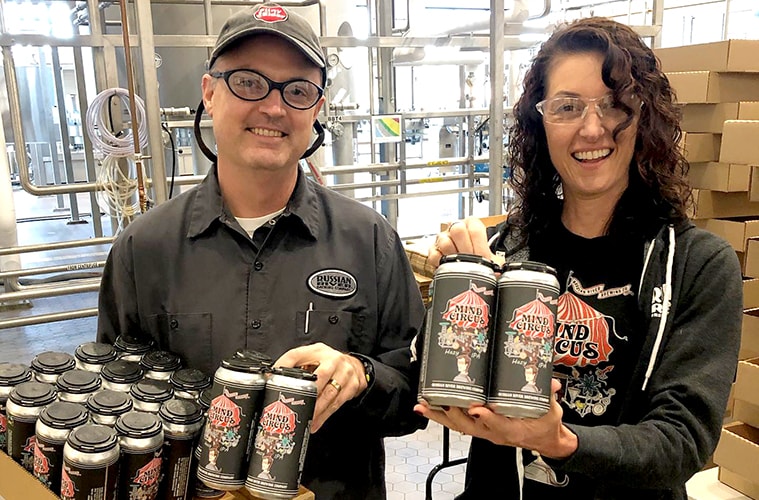
(Vinnie and Natalie Cilurzo with Russian River’s first canned beer)
Russian River, one of California’s last holdouts is “yielding to the can “and introducing its first canned offering EVER.
It was a big step for owners Natalie and Vinnie Cilurzo, who have long questioned the quality of beer in cans. Their new state-of-the-art brewery In Windsor, California wasn’t even designed to handle a canning line.
“We designed this brewery around bottling. That’s what we know and what we do really well,” Natalie Cilurzo told the Press Democrat. And yet the Cilurzos decided to release Mind Circus Hazy Pale Ale in 16oz cans.
 When Oskar Blues’ Dale Katechis began canning his beers back in 2002, many industry analysts (including us) were skeptical…After all, cans had long been associated with Big Beer, college frat parties and frankly, lesser beer.
When Oskar Blues’ Dale Katechis began canning his beers back in 2002, many industry analysts (including us) were skeptical…After all, cans had long been associated with Big Beer, college frat parties and frankly, lesser beer.
Craft beer had worked hard separate itself from the mainstream not only by its quality but also for its artful presentation. For many years bottles were seen as a defining and intrinsic part of the craft beer ethos.
Flash forward to 2019 and so many of those assumptions have been proven wrong. Not only is craft beer in cans being increasing accepted, we’re reaching a tipping point where more craft beer comes in cans rather than bottles
And here’s why…
Convenience – Canned craft beer is lighter and easier to transport. Plus it’s ideal for the kinds of activities that many of its fans embrace. But being lighter and more transportable isn’t just a boon for craft beer’s outdoor enthusiasts – it also means that cans are much cheaper for breweries to ship to retail. And in an industry where business margins can get incredibly tight – who doesn’t want that?
Freshness – Proponents of canning argue that cans provide a more effective light and oxygen barrier – and as a result that they preserve the beer’s freshness and integrity longer.
Sustainability – The craft brewing community is generally aligned with both the ecological and sustainability movements. And as the lighter cans are easier to ship, they leave a much smaller carbon emissions footprint. Cans can also be recycled and back on store shelves in 60 days.
Can Technology Has Improved – Innovations over the last couple of years have led to cans that just function better. Newly designed pouring lips now accentuate the beer’s aromatics. Different sizes abound and we’re even seeing more re-sealable cans now. Boston Beer’s Jim Koch, once a fierce opponent of canning, introduced his own newly designed “Sam Can” – and is now a leading participant in the movement.
Canning Is Smart Business – The canning industry is evolving too and creating all kinds of business options that both start-ups and established craft brewers are increasingly taking advantage of. Smaller breweries are lowering their capital expenditures by turning to a growing number of mobile canning operations. Canning lines also take up less brewery square footage further lowering overhead, plus they are cheaper to maintain than most bottling operations. In addition to affording everyone lower shipping costs (see #1), cans take up less space, so they are cheaper to warehouse as well.
You – The consumer’s perception of craft beer in cans has changed profoundly over the last decade and what was once ‘not cool’ is now commonplace. New breweries have grown passionate followings with can-only products and have accustomed its fans as to the righteousness of the canned concept at the same time.
All images courtesy of Russian River Brewing Company
 American Craft Beer The Best Craft Beer, Breweries, Bars, Brewpubs, Beer Stores, And Restaurants Serving Serious Beer.
American Craft Beer The Best Craft Beer, Breweries, Bars, Brewpubs, Beer Stores, And Restaurants Serving Serious Beer.
